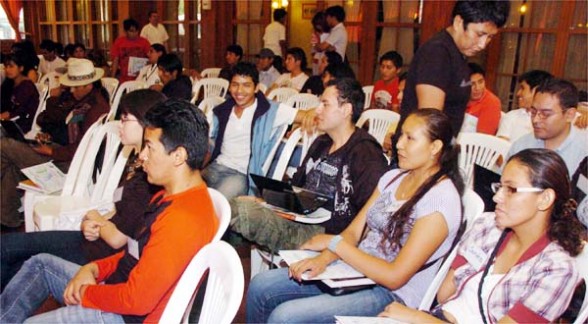Youth participation in Latin-American political parties: towards greater involvement
In spite of the progress made, there is no correspondence between the demographic relevance and the political importance of young people. They are the majority of the population in most of Latin-American countries; nevertheless, they are still excluded from most of power spaces and decision-making processes. Political parties are not the exception. The purpose of this article is to present an overview on this topic and some ideas that are being currently discussed in order to improve the participation of young people in political parties.

A recent research conducted by the Inter-American Development Bank and International Idea (GEPPAL)[1]shows that youth participation in Latin American political parties is, in most of the cases, reduced, and even inexistent.
In general terms, the research data base shows that few political parties know precisely its number of young members. The majority has “youth units”, although not all of them function effectively, and only a few receive economical resources for their activities. Most of the parties included in the research state having youth training policies, but there is no information regarding their regularity and/or effectiveness. Only a small number of parties have mechanisms to promote young people’s participation, such as quotas in candidates’ lists or reserved seats for internal positions. As a result, there are not many young people in responsibility / high-ranking positions within the parties’ structure or in parliaments and other state institutions. Other sources highlight that young people are excluded from parties’ internal decision processes and their participation is mostly – or even only – required in election times, due to their high voting potential[2].
On the one hand, this reduced participation is related to adult-centrist view of youth as a problem. On the other hand, this low involvement is also linked to the lack of confidence toward politicians, parties and public institutions among young people that prevails in most of Latin American countries, a fact that discourages them from participating. This situation has worsened in the context of the political party system crisis that many countries are undergoing/ have undergone. Political culture and unfinished citizenship processes are also factors that have to be taken into account for a better understanding of this situation.
This raises an important question: does low participation of young people in political parties reflect low interest of this portion of the population in politics? Some researchers consider that, in fact, the massive involvement of young people in social protests shows disaffection toward the traditional participation channels more than disaffection toward politics[3].
In this context, what could be done in order to promote increased participation of young people in political parties? The recuperation of political parties’ legitimacy and reliability seems to be a crucial element. According to many academics, this objective could be achieved only through the execution of major changes within parties, such as undertaking effective internal democratization processes. In turn, it is only possible through the involvement and participation of traditionally excluded sectors, such as women, indigenous and young people. In this context the debate regarding the adoption of quota policies as an inclusion mechanism has emerged.
Although for some reserving political quotas —such as seats in parliaments or positions within parties— is a method to balance structural power inequities, for others this does not guarantee the quality of participation and representation and could even violate principles of —liberal— democracy[4].
Gender quotas are being applied in many countries around the world as a measure to generate more participation of women in politics; it is proved that it has had a positive impact in Latin America. According to the GEPPAL project, female participation in parliaments of countries with mandatory quotas has increased in a higher proportion than in countries that have not implemented the mechanism. According to another research, female participation in countries with quotas has increased more than 100%, while in countries without quotas it has not augmented more than 50%[5].
Regarding youth quotas, the majority of Latin-American countries do not have laws including this mechanism; reserving political seats for young people is an autonomous decision of each political party that, as showed before, is not being taken in most of the cases. The exception of the rule is Peru, the only country that has a national law that obliges parties to include youth quotas in candidates’ lists for local elections, showing positive results indeed[6].
It is clear that quotas are not a perfect mechanism and that they should be accompanied with other effective measures. Nevertheless, they can represent one step further in terms of internal democratization of political parties and a bigger participation of youth people in politics.
Jimena Avejera
[1] http://www.iadb.org/research/geppal/
[2] Zovatto, D. 2008 (Coord.), Regulación jurídica de los partidos políticos en América Latina, Instituto de Investigaciones Jurídicas, Idea Internacional, México
[3] Mella, M. 2009. Entrevista sobre la democracia en los partidos políticos, Revista Temas para el Debate, sección “Temas Candentes”, Madrid
[4] http://www.quotaproject.org/aboutQuotas.cfm
[5] Oficina Nacional de Procesos Electorales (Perú). 2008, Nuevos actores en el mapa político. La cuota de género y la cuota de jóvenes en las elecciones regionales y municipales de 2006. Documento de Trabajo Nº 18, ONPE, Lima
[6] Ibidem